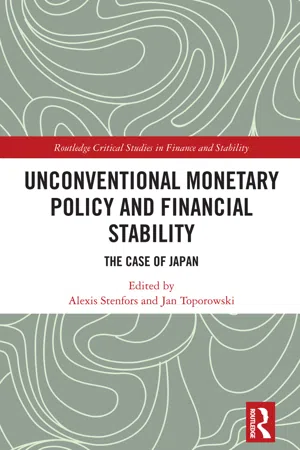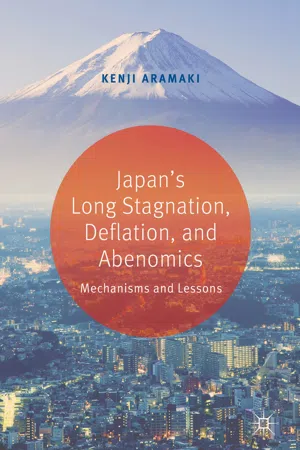Abenomics
Abenomics refers to the economic policies implemented by Japanese Prime Minister Shinzo Abe, aimed at revitalizing the country's economy. The three main pillars of Abenomics are monetary easing, fiscal stimulus, and structural reforms. The goal is to combat deflation, boost economic growth, and address long-standing issues such as an aging population and low productivity.
7 Key excerpts on "Abenomics"
- eBook - ePub
Japanese Political Economy Revisited
Abenomics and Institutional Change
- David Chiavacci, Sébastien Lechevalier, David Chiavacci, Sébastien Lechevalier(Authors)
- 2020(Publication Date)
- Routledge(Publisher)
...Re-packaging old policies? ‘Abenomics’ and the lack of an alternative growth model for Japan’s political economy SAORI SHIBATA Abstract : 'Abenomics' has continued to attract the attention of both the national and international media and a broad range of scholars. There are different and contested views of Abenomics and its impact upon the Japanese economy. This article argues that those more Keynesian-style remedies that form part of Abenomics have not been able to address Japan's longer-term problem of weak demand, especially in terms of private consumption. This is in large part due to the liberalising measures that also form part of Abenomics, and which are incompatible with the Keynesian remedies pursued. Whilst Abenomics has the potential (at least in the short-to-medium term) to improve the profitability of Japanese businesses, in the absence of a corresponding move to redistribute corporate wealth to labour, Abenomics also represents a hazard to future economic growth in Japan. Introduction Since Prime Minister Abe announced his strategy to revive Japan's economy in 2013 the term 'Abenomics' has continued to attract the attention of both the national and international media and a broad range of scholars. Discussions have tended to vary in terms of the degree of support voiced for Abenomics. Many of the early observations made in the national and international media were positive, noting especially the boost to stock prices and the depreciation of the yen. Evaluations have tended subsequently to divide into three groups. The first group of commentators have praised Abenomics, highlighting the effects of the expansionary monetary policy upon expected inflation, the resultant increase in stock prices and general increase in corporate profits, and the increased rate of employment and level of public consumption (IMF 2013, Hausman and Wieland 2014)...
- eBook - ePub
- Hiroaki Richard Watanabe(Author)
- 2020(Publication Date)
- Agenda Publishing(Publisher)
...The (perceived) mishandling of the 3.11 triple disasters 8 by the administration of Prime Minister Kan also affected the popularity of the DPJ negatively. The DPJ suffered a huge loss in the election to the House of Representatives in 2012 and lost power. LDP’S RETURN TO POWER AND THE IMPLEMENTATION OF “Abenomics” The LDP came back to power in December 2012. Abe Shinzō, who had been prime minister after Koizumi for less than a year due to the LDP’s loss in the election to the House of Councillors in 2007 and his poor health, became prime minister again. Based on his understanding that the failure of his first administration was due to his focus on politically controversial issues such as constitutional change, Prime Minister Abe adopted a survival strategy of economy first and announced the launch of an economic policy entitled “Abenomics”. In Abenomics, economic growth is considered the number one priority. However, it can also be considered as an essential tool for the Abe administration to achieve its ultimate goal of constitutional reform by maintaining popular support for the administration with strong economic growth and thus remaining in power. Abenomics: monetary policy, fiscal policy and structural reform Abenomics was composed of three “arrows” of “monetary policy”, “fiscal policy” and “structural reform”. The term “arrows” means the instruments for targeting the goal of economic growth in comparison to “archery”, which Prime Minister Abe practiced when he was a university student. Among these three policies, the most significant was monetary policy, which targeted 2 per cent inflation with the BOJ’s purchase of government bonds and an increase in the money supply. Fiscal policy was essentially the same as that implemented by previous LDP administrations and was mostly concerned with spending tax money on public works and increasing jobs in the construction and other relevant sectors...
- eBook - ePub
Unconventional Monetary Policy and Financial Stability
The Case of Japan
- Alexis Stenfors, Jan Toporowski, Alexis Stenfors, Jan Toporowski(Authors)
- 2020(Publication Date)
- Routledge(Publisher)
...5). The primary aim of Abe, as with many of his predecessors, has been to end decades of stagnation and deflation, returning to sustainable economic growth. The policy package launched, dubbed ‘three arrows of Abenomics’, was composed of fiscal stimulus, massive monetary expansion and structural reforms in line with a growth strategy, which to a large extent aimed at promoting private investment. The combined aim of the three arrows was to achieve “a vibrant economy that will register over 2% labor productivity in the medium- to long-term, and around 3% nominal gross domestic product (GDP) growth and around 2% real GDP growth, on average, over the next ten years” (Prime Minister of Japan and His Cabinet – Kantei, 2013, p. 2). The monetary arrow By far the most pronounced measures have been those taken on the monetary front. In this pursuit, Prime Minister Abe needed a strong ally in the key position of the central bank’s governor, which he found when Kuroda assumed his current office in March 2013. Soon after, in April 2013 the Bank of Japan introduced Quantitative and Qualitative Monetary Easing (QQE): the monetary base became the main operating target instead of the uncollateralised overnight call rate, an inflation target of 2% was introduced and large-scale asset purchases at a rate of ¥60–70 trillion per year was initiated (Bank of Japan, 2013). Governor Kuroda summarised the main channels through which he expected the stimulus to be transmitted in a speech to the Yomiuri International Economic Society in Tokyo in April 2013. First, he argued the purchase of Japanese government bonds (JGBs), exchange-traded funds (ETFs) and Japanese real estate investment trusts (J-REITs) would create downward pressure on long-term rates and decrease risk premia, stimulating demand for credit...
- eBook - ePub
The Japanese Economy
Strategies to Cope with a Shrinking and Ageing Population
- Randall Jones(Author)
- 2022(Publication Date)
- Routledge(Publisher)
...Japan’s current account surplus, which has been a point of contention with some of its major trading partners, also fell (see Chapter 9). Abenomics Japan’s annual real GDP growth during 1992–2012 slowed to 0.7%, compared to 2.3% in the OECD countries combined (Figure 1.9). Even in per capita terms, it was less than one-half of that of the OECD countries. Shinjiro Abe of the LDP was elected Prime Minister for the second time in 2012, promising economic revival under the slogan ‘Take back Japan’. Abe launched a three-arrow strategy known as ‘Abenomics’: bold monetary policy, flexible fiscal policy and structural reforms to boost growth. Each arrow was essential to put Japan on a path to fiscal sustainability by raising inflation to the BoJ’s target, implementing fiscal measures to increase revenue and limit spending growth, and structural reforms to boost productivity and real growth. Figure 1.9 Japan’s per capita GDP growth has accelerated since 2012: annual average percentage growth Source: Author’s elaboration OECD data, Statistical Annex, OECD Economic Outlook No. 108 – December 2020, www.oecd.org/economy/outlook/statistical-annex/ and Historical Population, OECD.Stat, https://stats.oecd.org/Index.aspx?DataSetCode=HISTPOP (accessed 21 May 2021). The first arrow: bold monetary policy In January 2013, the BoJ set a 2% inflation target that it aimed to reach ‘at the earliest possible time’. To achieve it, the new BoJ governor, Haruhiko Kuroda, launched quantitative and qualitative monetary easing (QQE), a clear break from past policies in terms of scale, decisiveness and ambition (see Chapter 21). The new policy had an immediate impact: CPI inflation reached 1.5% (year-on-year) before the April 2014 consumption tax hike (Figure 1.10). Much of the impact of QQE came through the yen exchange rate, which had appreciated by 41% in effective terms during 2007–12 (Figure 1.4). The expansionary monetary policy reversed 90% of the appreciation by 2015...
- eBook - ePub
Japan's Long Stagnation, Deflation, and Abenomics
Mechanisms and Lessons
- Kenji Aramaki(Author)
- 2019(Publication Date)
- Palgrave Macmillan(Publisher)
...Expectation of population decline exists as an additional source of concern for both companies and households. Through all these channels, the Japanese economy has been led to an equilibrium governed by low-growth expectation and wariness about the future. In late 2012, the Liberal Democratic Party (LDP) came back to the power, and Mr. Shinzo Abe, President of the LDP, started his second premiership. He initiated a comprehensive package of economic policies, which was soon dubbed “Abenomics.” Initial responses in the markets were quite significant. We will see in this chapter, first, what the Abenomics is; second, what impacts it has brought about; and, third, whether the core problem of the Japanese economy has been addressed and improved. 1 Abenomics Start of Abenomics On November 14, 2012, then Prime Minister (PM) Noda of the Democratic Party (DP) declared in the Parliamentary discussion with Mr. Abe, president of the LDP, that he would dissolve the House of Representatives in two days, that is, on November 16. In the election on December 16, the LDP had won a landslide victory, gaining 294 seats from the pre-election level of 119, out of the total 480 seats, while the DP suffered a crushing defeat of reducing its seats by three-fourths from 230 to 57. On December 26, 2012, the second Abe administration started and adopted its “Basic Policy” in the first cabinet meeting, in which it was stated about the economy: A strong economy is the source of Japan’s strength...
- eBook - ePub
Japan's Great Stagnation and Abenomics
Lessons for the World
- Masazumi Wakatabe(Author)
- 2015(Publication Date)
- Palgrave Macmillan(Publisher)
...The initial phase has worked well, but there is uncertainty in the future. Abenomics has two faces: politics and economics. Abenomics is a product of political compromise among powerful LDP politicians, but it also makes sense as an economic policy for tackling deflation. Chapter 5 argues possible risks and the prospects of Abenomics. Here again, the course of action depends on economic policy ideas, and success depends on whether Shinzo Abe and his successors avoid the policy idea trap and bad economic policy ideas. The last chapter of the book, Chapter 6, “Concluding Remarks: Beware of Japanization,” summarizes what went wrong in Japan, why Japan went wrong, and what the lessons are for the world. Japan went wrong because of four macroeconomic and other mistakes that occurred from 1985 to 2012. Japan’s macroeconomic policy toward the exchange rate control was derailed when the Plaza Accord was agreed on in 1985. Then the Japanese policymakers allowed a violent fluctuation in asset prices, generating the so-called bubble. Bursting the bubble was also problematic; they did too little to counter the subsequent asset deflation and general deflation. Japan’s policymakers made mistakes in other areas, such as the resolution of the bad loans problem. The reasons that Japan made mistakes were multifold. There were surely institutional and even “structural” problems in the policymaking process. But it is most important that bad economic ideas became pervasive. The biggest lesson of all is that everyone can make mistakes and can learn from them. Nevertheless, the controversy tends to be prolonged: old ideas never die out, and they may gain influence in the time of a crisis....
- eBook - ePub
The Power to Compete
An Economist and an Entrepreneur on Revitalizing Japan in the Global Economy
- Hiroshi Mikitani, Ryoichi Mikitani(Authors)
- 2014(Publication Date)
- Wiley(Publisher)
...Chapter 3 The Power in Questioning Abenomics History of Abenomics Hiroshi I selected innovation and operational capability as the pillars of my “Japan Again” proposal in line with the Japan revitalization strategy. These are closely related to the growth strategy, which is the third of the three arrows of Abenomics. I would like to talk about the first and second arrows of Abenomics: bold monetary policy and fiscal policy. Let's start with a broad discussion of Abenomics. At the Japan Association of New Economy's Abenomics Forum in June 2013, Professor Heizo Takenaka of Keio University said that Abenomics was 100 percent correct. Robert Feldman of Morgan Stanley MUFG Securities has also praised it highly, calling it a grand slam. As an economist, how do you feel about it? Ryoichi: I think Prime Minister Abe is currently steadily advancing and implementing his plan. I believe he possesses excellent political acumen. Hiroshi: Perhaps he learned from the failure of the first Abe administration. I know of a certain start-up firm in the United States that failed at its first launch attempt, losing all of its four billion yen [$40 million] in funding. But the second time around, the same investors all gave just as much as they did the first time. Ryoichi: Up to this point, banks have been very sensitive to the attitudes of the Bank of Japan and Ministry of Finance when investing in companies. They have not been favorable to investments in risky businesses. We do not have as many individual investors here as they do in the United States. I think Japanese people tend to be risk averse, and, accordingly, banks and securities firms are also safety-focused. I think this presents a tremendous obstacle to the liberalization of the financial sector in Japan. Hiroshi: In the United States, investors play the role of sources of investment for venture or start-up firms that also raise economic efficiency and innovation. But in Japan, the main source of investments is from banks...






